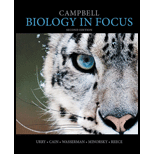
Campbell Biology in Focus (2nd Edition)
2nd Edition
ISBN: 9780321962751
Author: Lisa A. Urry, Michael L. Cain, Steven A. Wasserman, Peter V. Minorsky, Jane B. Reece
Publisher: PEARSON
expand_more
expand_more
format_list_bulleted
Concept explainers
Question
Chapter 7.4, Problem 1CC
Summary Introduction
To explain:
The effect of absence of oxygen at the end of the electron transport chain.
Concept introduction:
The final step of
Expert Solution & Answer
Want to see the full answer?
Check out a sample textbook solution
Students have asked these similar questions
Explain how is O2 used during Cell Respiration?
What chemical is the acceptor of carbon dioxide in the C3 cycle? What enzyme catalyzes the reaction, and what is the product?
Unlike the cyanobacteria, the anoxygenic photosynthetic bacteria do not produce O2 . Why not?
Chapter 7 Solutions
Campbell Biology in Focus (2nd Edition)
Ch. 7.1 - Compare and contrast aerobic and anaerobic...Ch. 7.1 - Name and describe the two ways in which ATP is...Ch. 7.1 - Prob. 3CCCh. 7.2 - During step 6 in Figure 7.9, which molecule acts...Ch. 7.3 - Name the molecules that conserve most of the...Ch. 7.3 - Prob. 2CCCh. 7.4 - Prob. 1CCCh. 7.4 - Prob. 2CCCh. 7.4 - MAKE CONNECTIONS Membranes must be fluid to...Ch. 7.5 - Prob. 1CC
Ch. 7.5 - WHAT IF? A glucose-fed yeast cell is moved from an...Ch. 7.6 - MAKE CONNECTIONS Compare the structure of a fat...Ch. 7.6 - Prob. 2CCCh. 7.6 - WHAT IF? During intense exercise, can a muscle...Ch. 7 - The immediate energy source that drives ATP...Ch. 7 - Which metabolic pathway is common to both...Ch. 7 - In mitochondria, exergonic redox reactions A. are...Ch. 7 - The final electron acceptor of the electron...Ch. 7 - What is the oxidizing agent in the following...Ch. 7 - When electrons flow along the electron transport...Ch. 7 - Most co, from catabolism is released during A....Ch. 7 - DRAW IT The graph here shows the pH difference...Ch. 7 - INTERPRET THE DATA Phosphofructokinase is an...Ch. 7 - Prob. 10TYUCh. 7 - FOCUS ON EVOLUTION ATP synthases are found in the...Ch. 7 - Prob. 12TYUCh. 7 - Prob. 13TYU
Knowledge Booster
Learn more about
Need a deep-dive on the concept behind this application? Look no further. Learn more about this topic, biology and related others by exploring similar questions and additional content below.Similar questions
- What would be some of the challenges involved in removing respiratory complexes from the inner mitochondrial membrane in order to study their properties?arrow_forwardDoes Kreb cycle require oxygen?arrow_forwardIf 40 molecules of glucose enter into cellular respiration in the presence of O2, how many molecules CO2 will be produced in the CAC only?arrow_forward
- The gas given off as a by product of cellular respiration is ?arrow_forwardWhich step(s) of cellular respiration would be directly inhibited by a lack of O2? How would this affect other steps of cellular respiration? Hint: Consider your answers to question 5.arrow_forwardWhat is the enzyme that catalyzes the reaction CO2 + H2O ⇌ H2CO3 in human tissues, including blood?arrow_forward
- If oxygen is not available for the electron transport chain, how is the Krebs cycle affected? What is the alternative pathway that the cells would opt to respire?arrow_forwardIs NADH a protein?arrow_forwardDoes a negative change in carbon dioxide per minute indicate photosynthesis or cellular respiration?arrow_forward
arrow_back_ios
SEE MORE QUESTIONS
arrow_forward_ios
Recommended textbooks for you


Mitochondrial mutations; Author: Useful Genetics;https://www.youtube.com/watch?v=GvgXe-3RJeU;License: CC-BY